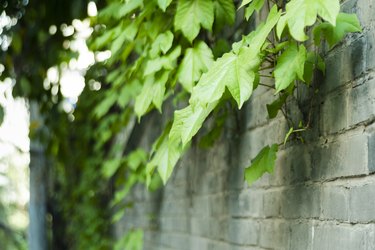
Certain species and cultivars of ivy plants like full sun, making them good candidates for your sunny areas. Ivy describes a variety of creeping and climbing vines used as a landscape ground cover or to cover buildings to give them a genteel, aged appearance.
Tip
There’s no single answer to whether ivy plants like full sun since different ivy species have different sun tolerances. Sun-loving varieties thrive in full sun to partial shade; shade-loving types thrive in dappled to deep shade.
Video of the Day
Ivy Plant Varieties
A popular sun-loving ivy variety is Boston ivy (Parthenocissus tricuspidata, USDA zones 4-8), a deciduous winter-hardy ivy. Its triple-lobed leaves turn bright burgundy in the fall before being shed for winter. Boston ivy does best in full sun, but it can also grow well in partial sun.
Video of the Day
Other varieties can handle some sun but prefer partial shade. Persian ivy (Hedera colchica, zones 6-9) is an evergreen ivy with large, thick leaves, suited for southern states. It thrives in part to full shade. Japanese ivy (Hedera rhombea, zones 8-9) has evergreen leaves with a narrow cream margin, and is suited to southern states. It can handle full sun, partial shade and dappled sunlight conditions.
Popular shade-loving ivy includes English ivy (Hedera helix, zones 4-13), an evergreen ivy with tri-lobed leaves that's moderately winter hardy. Algerian ivy (Hedera canariensis, zones 7-9) is an evergreen ivy with large green and bronze leaves, suited for southern states.
Indoor Ivy Plants
Some ivy varieties can also be grown as indoor plants in containers. English ivy is one such variety that typically likes bright but not direct sunlight. The ivy houseplant can likely survive in low and medium light situations, but you might notice that its growth slows. Variegated ivy might turn to an all-green look in lower sun levels.
Where to Plant Ivy Plants
Ivy prefers moist but well-drained soil rich in organic matter, such as is found on the forest floor. Ivy plants don't like standing water. As a landscape plant, ivy does well on steep or shaded banks and areas under trees that are too shady for grass. It also does well as an underplanting between shrubs.
As a horizontal creeping vine, many varieties may only grow to about 6 to 8 inches high above ground because of the leaf stems and foliage, although they may scramble along the ground on long stems that may reach 50 feet in length. All ivy varieties are excellent climbers, covering walls, fences or trellises. Ivy grows vertically by extending rootlets with adhesive tips that cling tightly to brick, masonry or wood.
Propagation and Planting
You can propagate most ivy plants by cutting off several inches of a growing vine tip and putting it in water. Roots will emerge in about a month or less, and the cutting is ready to plant. Plant the cutting in the ground deep enough to cover all the roots and put a couple of inches of moist soil on top.
You also can spread ivy by putting a growing vine tip several inches in the ground and covering with soil. The tip will sprout roots and grow into a new vine. Space plants about a foot or two apart for fast coverage. There are ivy varieties that are winter hardy in most of the U.S. snowbelt states.
Ivy Invasion Danger
In areas with mild winters, any ivy can become an invasive weed if not kept in check. The edges of your ivy patches need to be trimmed back two or three times a year. If the ground cover has gotten thicker than you want, use a hedge trimmer to cut it back down. This is best done in spring so new growth will quickly cover bald spots. Keeping ivy trimmed also will deter problems from slugs, snails, rodents and fungal diseases.
If ivy has invaded or you want to remove ivy from siding, cut the main stems at the root and apply a weed killer to the cut surfaces of the root to prevent new shoots. Then pull up the unwanted top growth and dispose of it in the trash or by burning.